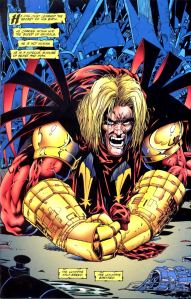Terry McGinnis – The Batman of the Future
You’re a teenager in high school. You’re surrounded by jocks, uptight girls, computer geeks, and so on. A short stint of juvenile delinquency makes you hostile to authority. One night, you blow off your father to be with your girlfriend. Normal day. Only when you get home you find your father’s been murdered by street thugs. Broken with grief, you stumble upon evidence of a corporate cover-up. With the police in the corporation’s pocket, your only option is to join forces with an aging Bruce Wayne whose reclusiveness forces your hand: you steal his Batsuit and become the new Batman. When you actually succeed in taking the corporation down, Wayne offers you the chance to restore justice to a bewildered Gotham City.
If all of the above actually happened, then you’re Terry McGinnis, the protagonist of the DC Animated show Batman Beyond, and the Batman of the future. Strap yourselves in; this is going to be a bumpy ride.
Terry McGinnis is not Bruce Wayne. Wayne committed to the crusade of Gotham almost immediately after losing his parents. Every minute of his life was spent in training: becoming experts in multiple scientific fields, man-hunting, escape artists, and the like. In his own mind, Bruce Wayne is the disguise: it’s the Batman that’s real.
But Terry faces an even more dangerous environment: high school. As Batman he prowls the night for criminals, but as Terry McGinnis he juggles school-work, family-time, and all the things that made high school a war-zone for its’ attendees. Of particular note is the strain of lying to his girlfriend Dana Tan. Wayne’s perfectionist demands, coupled with the Batman duties becoming top priority, strains their relationship to the breaking point.
That’s the beauty of Bruce Wayne’s Batman. He has no emotional ties to wear him down. Being Batman become an obsession that demanded the sacrifice of an ordinary life; love and companionship were distractions that ultimately got people killed.
Terry, on the other hand, has too many emotional ties. Wayne’s Batman could battle criminals without concern of his own life because he had no one to come home to. But Terry does. Having someone to come home inevitably forces you to think of how one’s death will hurt others. That in turn causes Terry to hesitate (even if he’s not aware of it). When dealing with ruthless criminals, hesitation gets people killed.
But being Batman has made Terry stronger, as well. Originally a cynic veteran of Gotham’s lawless streets, Terry’s duties as Batman has made him appreciate his family more. His often confrontational relationship with his surviving family softens to genuine support and caring. Terry’s a better big brother, a better son, because of Batman.
It takes a special commitment to be Batman. Bruce Wayne sacrificed all chances of a normal life to become the Batman his city desperately needed. But Terry had a life before Batman. He has family and friends to think about: something that Bruce never allowed himself to have. Terry McGinnis isn’t Bruce Wayne, but it turns out he doesn’t need to be. It’s the people in Terry’s life that gives him strength, which gives him the maturity to grow out of his juvenile former self and find his place in the world. You should definitely give Terry McGinnis a chance. You’ll be pleasantly surprised.

















